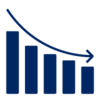The NSW Government is committed to making NSW sustainable, liveable and resilient. To achieve this, we aim to lead by example by reducing our environmental impact by using resources more efficiently.
The Government Resource Efficiency Policy (GREP) is our plan to achieve greater resource efficiency, cut costs and protect our environment. It outlines how the NSW Government will save resources in our own operations. The report on these pages tracks our performance against this plan.
Highlights



All mandated NSW Government agencies have submitted Government Resource Efficiency Policy (GREP) reports for 2021-22. General government sector agencies with 100+ employees are required to report. 100% of these agencies reported.
An increasing number of agencies are showing leadership in sustainability and embracing resource efficiency in their programs and operations.
During 2021-22, 17 out of 96 reporting government agencies achieved their E1 energy efficiency target, 2 years ahead of the 2024 target.
Reports
Read more about how we’re using fewer resources in line with the GREP and tracking against our targets for:
- Energy
- Energy target 1 (E1) - save energy across all government sites
- Energy target 5 (E5) - whole-of-government solar target
- Water
- Waste
You can view individual agency reports on the Centralised Analysis System for Performance of Energy and Resources (CASPER).
What’s next
In 2022-23, NSW Government agencies will begin reporting their electric and hybrid vehicle purchases. Agencies will also be able to voluntarily report if they have a net zero plan, recycled content procurement plan or NABERS waste ratings.
Also starting now, agencies will use a new reporting system. This system will improve data management, increasing data accuracy. The new system also introduces new processes to validate data.
Energy



In 2021-22, NSW Government energy use and cost decreased for the fifth year in a row.
Government agencies reported:
- 2,016 GWh of energy used in 2021-22, which is a 3.7% decrease from 2020-21
- $18.2 million saved, which cut the total cost of energy by 6% to $297.7 million.
This lower energy use can be attributed to a range of factors, including:
- energy efficiency projects such as lighting and HVAC upgrades
- installing solar PV on government rooftops
- using building performance ratings to manage a more energy-efficient property portfolio.
Agency energy use came from the following sources:
- 74% electricity
- 22% natural gas
- 4% LPG.
Although the energy use in 2021-22 is similar to the baseline year 2012-13, the scope of government operations has expanded over this period.
Reducing the Government’s energy use through energy efficiency and solar projects has significant benefits, including:
- decreasing the demand for energy
- promoting clean and renewable energy
- increasing the demand for low energy-use appliances
- encouraging the incorporation of energy efficiency design principles in new buildings.
Energy target 1 (E1) - save energy across all government sites



The E1 target requires agencies to reduce their energy use by 10% by 2023-24 (compared to what they used in their designated baseline year).
In 2021-22, NSW Government agencies reported 43 new energy efficiency projects to help achieve the E1 target. These include:
- improved heating, ventilation and air conditioning (HVAC) systems
- installing insulation
- upgrading LED lighting.
These 43 energy efficiency projects will save an estimated $1 million in costs and 31.7 million kWh per year in energy used.
NSW Government agencies have been working towards the E1 target since 2012-13. Reported savings from all E1 energy efficiency projects under the GREP are:
- $98 million in costs
- 608 million kWh in energy use.
That’s enough to run 110,000 NSW homes for a year according to the Australian Energy Regulator’s 2020 estimate of 5629 kWh/year average energy use per home.
The 17 agencies listed below have now achieved their 10% E1 energy savings, 2 years ahead of the 2023-24 target. Together, these agencies have saved 91 million kWh of energy annually, avoiding 71,000 tonnes of CO2 equivalent emissions each year:
- Aboriginal Housing Office
- Australian Museum
- Crown Solicitor’s Office
- Department of Education
- Greater Sydney Parklands – Centennial Park and Moore Park Trust
- Illawarra Shoalhaven Local Health District
- Law Enforcement Conduct Commission
- Mid North Coast Local Health District
- Nepean Blue Mountains Local Health District
- Northern NSW Local Health District
- Ombudsman’s Office
- Property and Development NSW
- Royal Botanic Gardens and Domain Trust
- Rural Fire Service
- State Library of NSW
- Sydney Living Museums
- Transport for NSW
Energy target 5 (E5) - whole-of-government solar target



The E5 target requires agencies to install solar photovoltaics (PV) on suitable sites to achieve 55,000 MWh a year of solar by 2024. The NSW Government has exceeded this target.
The NSW Government has now installed 77,800 MWh of annual solar generation, saving $12.3 million a year on energy bills.
Agencies are now working towards the expanded target of 126,000 MWh a year by 2024 set by the Net Zero Plan Stage 1: 2020-2030.
Water
In 2021-22, water use increased by 2,000 megalitres (20%) compared to 2020-21. Water cost also increased by $1.8 million (4%) compared to 2020-21.
Water use increased by 17% and expenditure decreased by 1.6% since the baseline year 2013-14.
The increase in water use coincided with people returning to office work after COVID lockdowns and returns water use to pre-pandemic levels.
Waste
In 2021-22, 62 agencies reported 844,000 tonnes waste and $41 million waste disposal cost. This is compared to 52 agencies reporting in 2020-21.
2021-22 marks the first full year of data for agencies reporting from the recently introduced Whole of Government Waste Contract (c9698).
Where waste disposal weight reporting was previously inconsistent due to barriers accessing data from individual waste contract providers, the new contract has improved data accuracy and reliability, with a more comprehensive dataset using standard waste streams and units. As we receive more data in the future, we expect trends in the waste data to emerge.
The Waste disposal graph shows the waste weight data in tonnes. We have excluded data that was submitted in cubic metres and litres to avoid potential inaccuracies with conversion.
The top 3 waste streams by weight in 2021-22 are:
- clinical and pharmacy waste (771,454 t)
- general waste (52,681 t)
- liquid waste (8,060 t).
The top 3 waste streams by cost are the same as in 2020-21:
- general waste ($30,315,397)
- clinical and pharmacy waste ($3,998,197)
- comingled recyclables ($2,176,285).
Before 2021-22, we could not report on the top 3 waste streams by weight as a significant portion of the waste was reported in cubic metres and litres. This improved in 2021-22 as shown in the percentages of waste reported in tonnes each year:
- 97% in 2021-22
- 38% in 2020-21
- 72% in 2019-20
- 79% in 2018-19.